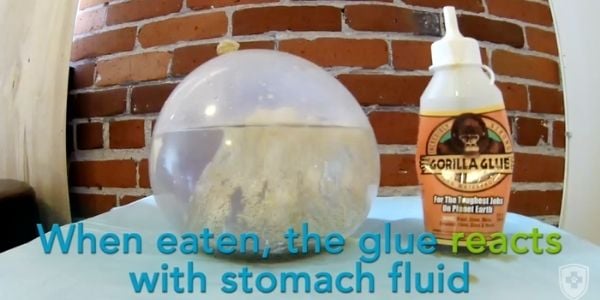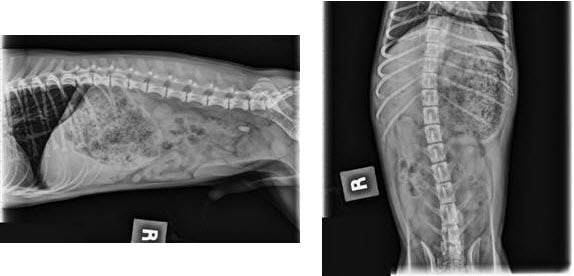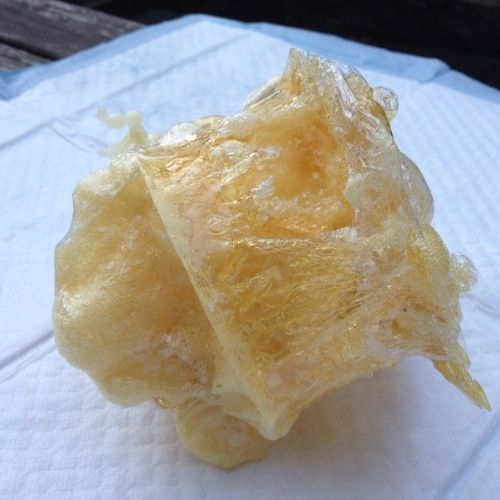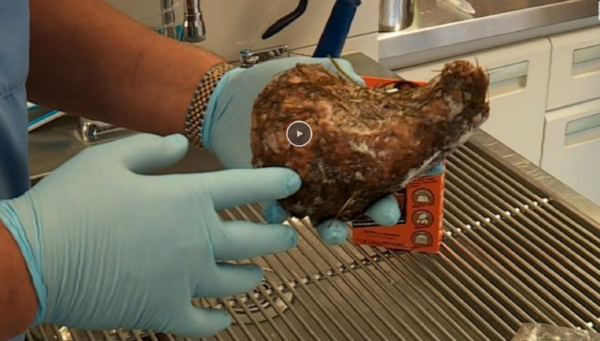 Polyurethane Glues Are Dangerous to Dogs
Polyurethane Glues Are Dangerous to Dogs
Gorilla Glue® is an incredibly strong glue known for its industrial holding power and versatility, even in wet conditions and regardless of the surfaces to be bound. It easily bonds wood, stone, metal, ceramic, foam, glass, and more. Because this glue is often found in many households, Gorilla Glue ingestion is a common emergency in dogs and is a very serious medical condition. If swallowed, any amount of this glue can expand to a size that may cause an obstruction of your dog’s stomach where emergency surgery would be necessary.
This time-lapse video, “When Gorilla Glue Gets Wet,” shows what happens when Gorilla Glue is eaten by a dog — which, given its sweet taste, happens far more often than you might think.

These two radiographs are of a dog with an obstructive Gorilla Glue mass in his stomach. (Images courtesy of Dr. Garret Pachtinger, VMD, DACVECC).
Beware when dealing with Gorilla Glue®
- Gorilla Glue ingestion is a common emergency in dogs and is a very serious medical condition.
- When working with Gorilla Glue, don’t allow your pets to be around you or your materials.
As many pet owners know, some dogs will eat almost anything, but the reason this particular substance is so attractive is because it has a sweet smell and taste. If you are going to have it around the house, it’s important to recognize the danger and take steps to prevent your pets from accessing it.
Here are some steps you can take to help keep your pets safe:
- Keep your Gorilla Glue and other isocyanate polyurethane adhesives in a sturdy toolbox on a stable, elevated shelf. Alternatively, keep them in a secure drawer or cabinet that is well out of your dog’s reach (be sure to take into account their height when they’re standing on their hind legs – “counter surfing”).
- Clean up any spills promptly and completely. Here’s how to clean up polyurethane glue spills.
- When working with Gorilla Glue, don’t allow your pets to be around you or your materials.
- Put away all of your materials when you’re finished working with them and clean up during breaks. (Or take steps to keep your pets away from your workspace until you are able to thoroughly clean up.)
- Avoid the potential for the problem entirely and don’t bring Gorilla Glue or other such adhesives into your home or another workspace.
- Ensure that all handymen, contractors, and other people doing work around your house exercise caution too. These types of adhesives aren’t just used for model building and do-it-yourself projects around the house; they’re also used frequently in construction, plumbing, marine, and other industries.
- Help increase awareness. Spread word about the dangers that Gorilla Glue and other isocyanate polyurethane adhesives pose to pets. It may not be in your home that your dog encounters and eats a bottle of Gorilla Glue, after all.
While this issue tends to affect dogs far more often, it can affect cats, too. If you have cats in the home, please follow the same preventive steps.

True Stories About Dogs and Their Encounters With Polyurethane Glue
Here's what Samantha C. shared with us:
"My dogs also got into this glue this week. They are still at the vet's recovering from surgery. My boxer had a basketball-sized amount removed from his stomach, and my Siberian Husky had a softball-sized amount removed. We were quoted $2K for their surgeries (total). They ate the glue in a fit of panic after I accidentally locked myself out of my apartment. They could hear me outside, and just freaked. They jumped up on a shelf in the laundry room, which they normally NEVER go into, and ate it."
We thank Samantha for sharing her story so that others may avoid a similar emergency. It can so easily happen to anyone! If this has happened to you please share your experiences below.
CNN's Jeanne Moos reports about Lake, a 6-month old Weimaraner




